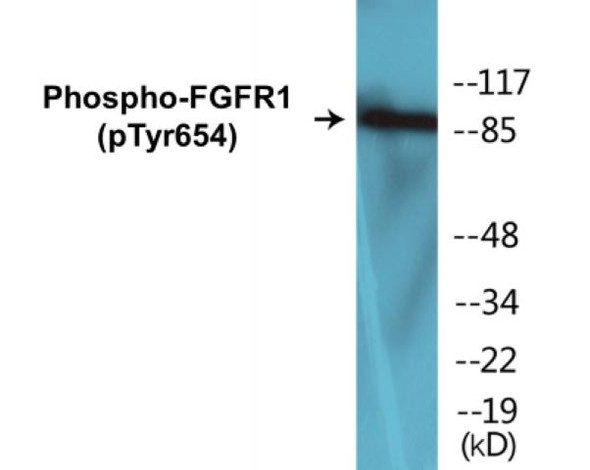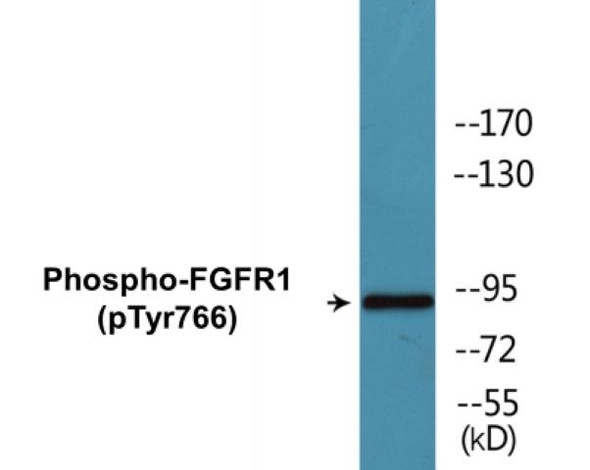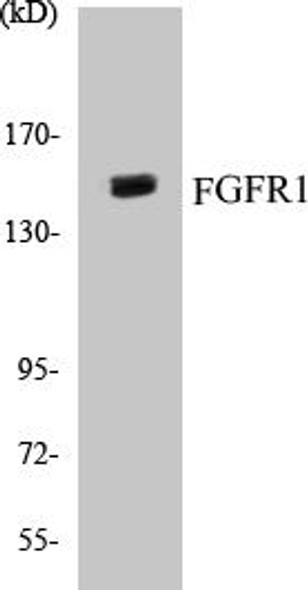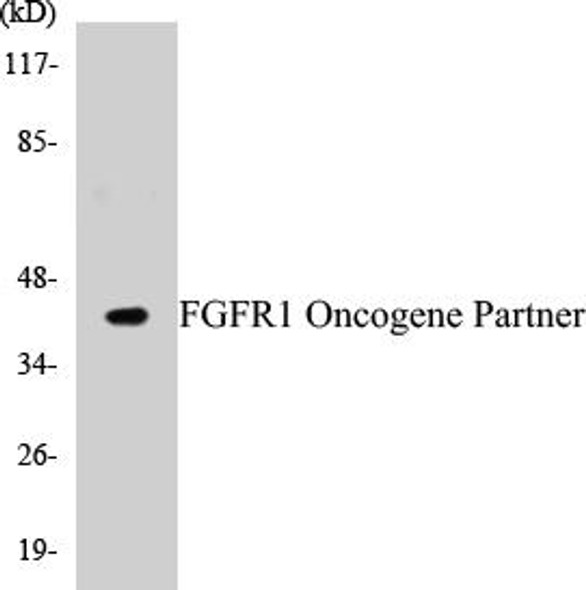Description
| Product Name: | FGFR1 (Phospho-Tyr154) Colorimetric Cell-Based ELISA |
| Product Code: | CBCAB01530 |
| ELISA Type: | Cell-Based |
| Target: | FGFR1 (Phospho-Tyr154) |
| Reactivity: | Human, Mouse, Rat |
| Dynamic Range: | > 5000 Cells |
| Detection Method: | Colorimetric 450 nm |
| Format: | 2 x 96-Well Microplates |
The FGFR1 (Phospho-Tyr154) Colorimetric Cell-Based ELISA Kit is a convenient, lysate-free, high throughput and sensitive assay kit that can detect FGFR1 protein phosphorylation and expression profile in cells. The kit can be used for measuring the relative amounts of phosphorylated FGFR1 in cultured cells as well as screening for the effects that various treatments, inhibitors (ie. siRNA or chemicals), or activators have on FGFR1 phosphorylation.
Qualitative determination of FGFR1 (Phospho-Tyr154) concentration is achieved by an indirect ELISA format. In essence, FGFR1 (Phospho-Tyr154) is captured by FGFR1 (Phospho-Tyr154)-specific primary (1ø) antibodies while the HRP-conjugated secondary (2ø) antibodies bind the Fc region of the 1ø antibody. Through this binding, the HRP enzyme conjugated to the 2ø antibody can catalyze a colorimetric reaction upon substrate addition. Due to the qualitative nature of the Cell-Based ELISA, multiple normalization methods are needed:
| 1. | A monoclonal antibody specific for human GAPDH is included to serve as an internal positive control in normalizing the target absorbance values. |
| 2. | Following the colorimetric measurement of HRP activity via substrate addition, the Crystal Violet whole-cell staining method may be used to determine cell density. After staining, the results can be analysed by normalizing the absorbance values to cell amounts, by which the plating difference can be adjusted. |
| Database Information: | Gene ID: 2260, UniProt ID: P11362, OMIM: 101600/136350/146110/147950/166250/190440, Unigene: Hs.264887 |
| Gene Symbol: | FGFR1 |
| Sub Type: | Phospho |
| UniProt Protein Function: | FGFR1: a receptor tyrosine kinase of the highly-conserved fibroblast growth factor receptor (FGFR). Binds both acidic and basic fibroblast growth factors and is involved in limb induction. Point mutations cause Pfeffer syndrome (finger and toe malformations and other skeletal errors) and dominant Kallmann syndrome 2. Stem cell leukemia lymphoma syndrome (SCLL) may be caused by a t(8;13)(p12;q12) translocation that fuses a zinc finger gene, ZNF198, to FGFR1. Various myeloproliferative disorders have been linked to translocations that fuse FGFR1 to FOP, FIM, CEP1 or the atypical kinase, Bcr. Inhibitor: SU5402. 20 isoforms of the human protein produced by alternative splicing have been described. |
| UniProt Protein Details: | Protein type:Protein kinase, TK; Protein kinase, tyrosine (receptor); Oncoprotein; EC 2.7.10.1; Membrane protein, integral; Kinase, protein; TK group; FGFR family Chromosomal Location of Human Ortholog: 8p11.23-p11.22 Cellular Component: integral to plasma membrane; cytoplasmic membrane-bound vesicle; extracellular region; plasma membrane; integral to membrane; nucleus; cytosol; receptor complex Molecular Function:heparin binding; identical protein binding; protein binding; fibroblast growth factor binding; protein homodimerization activity; fibroblast growth factor receptor activity; protein-tyrosine kinase activity; ATP binding Biological Process: paraxial mesoderm development; axon guidance; peptidyl-tyrosine phosphorylation; nerve growth factor receptor signaling pathway; protein amino acid autophosphorylation; cell maturation; neuron migration; negative regulation of transcription from RNA polymerase II promoter; middle ear morphogenesis; protein amino acid phosphorylation; positive regulation of MAP kinase activity; sensory perception of sound; positive regulation of MAPKKK cascade; ureteric bud development; regulation of cell differentiation; induction of an organ; midbrain development; positive regulation of mesenchymal cell proliferation; positive regulation of cell proliferation; chondrocyte differentiation; angiogenesis; skeletal development; embryonic limb morphogenesis; positive regulation of cardiac muscle cell proliferation; epidermal growth factor receptor signaling pathway; inner ear morphogenesis; cell migration; fibroblast growth factor receptor signaling pathway; phosphoinositide-mediated signaling; chordate embryonic development; transcription, DNA-dependent; in utero embryonic development; outer ear morphogenesis; MAPKKK cascade; positive regulation of cell cycle; neuroblast division in the ventricular zone; positive regulation of phosphoinositide 3-kinase cascade; mesenchymal cell differentiation; skeletal morphogenesis; insulin receptor signaling pathway; auditory receptor cell development; innate immune response; positive regulation of neuron differentiation; regulation of lateral mesodermal cell fate specification Disease: Pfeiffer Syndrome; Hypogonadotropic Hypogonadism 2 With Or Without Anosmia; Jackson-weiss Syndrome; Trigonocephaly 1; Osteoglophonic Dysplasia |
| NCBI Summary: | The protein encoded by this gene is a member of the fibroblast growth factor receptor (FGFR) family, where amino acid sequence is highly conserved between members and throughout evolution. FGFR family members differ from one another in their ligand affinities and tissue distribution. A full-length representative protein consists of an extracellular region, composed of three immunoglobulin-like domains, a single hydrophobic membrane-spanning segment and a cytoplasmic tyrosine kinase domain. The extracellular portion of the protein interacts with fibroblast growth factors, setting in motion a cascade of downstream signals, ultimately influencing mitogenesis and differentiation. This particular family member binds both acidic and basic fibroblast growth factors and is involved in limb induction. Mutations in this gene have been associated with Pfeiffer syndrome, Jackson-Weiss syndrome, Antley-Bixler syndrome, osteoglophonic dysplasia, and autosomal dominant Kallmann syndrome 2. Chromosomal aberrations involving this gene are associated with stem cell myeloproliferative disorder and stem cell leukemia lymphoma syndrome. Alternatively spliced variants which encode different protein isoforms have been described; however, not all variants have been fully characterized. [provided by RefSeq, Jul 2008] |
| UniProt Code: | P11362 |
| NCBI GenInfo Identifier: | 120046 |
| NCBI Gene ID: | 2260 |
| NCBI Accession: | P11362.3 |
| UniProt Secondary Accession: | P11362,P17049, Q02063, Q02065, Q14306, Q14307, Q53H63 Q59H40, Q5BJG2, A8K6T9, A8K8V5, C1KBH8, |
| UniProt Related Accession: | P11362 |
| Molecular Weight: | 91,868 Da |
| NCBI Full Name: | Fibroblast growth factor receptor 1 |
| NCBI Synonym Full Names: | fibroblast growth factor receptor 1 |
| NCBI Official Symbol: | FGFR1 |
| NCBI Official Synonym Symbols: | CEK; FLG; HH2; OGD; FLT2; KAL2; BFGFR; CD331; FGFBR; FLT-2; HBGFR; N-SAM; FGFR-1; HRTFDS; bFGF-R-1 |
| NCBI Protein Information: | fibroblast growth factor receptor 1; FGFR1/PLAG1 fusion; proto-oncogene c-Fgr; FMS-like tyrosine kinase 2; hydroxyaryl-protein kinase; fms-related tyrosine kinase 2; heparin-binding growth factor receptor; basic fibroblast growth factor receptor 1 |
| UniProt Protein Name: | Fibroblast growth factor receptor 1 |
| UniProt Synonym Protein Names: | Basic fibroblast growth factor receptor 1; BFGFR; bFGF-R-1; Fms-like tyrosine kinase 2; FLT-2; N-sam; Proto-oncogene c-Fgr |
| UniProt Gene Name: | FGFR1 |
| UniProt Entry Name: | FGFR1_HUMAN |
| Component | Quantity |
| 96-Well Cell Culture Clear-Bottom Microplate | 2 plates |
| 10X TBS | 24 mL |
| Quenching Buffer | 24 mL |
| Blocking Buffer | 50 mL |
| 15X Wash Buffer | 50 mL |
| Primary Antibody Diluent | 12 mL |
| 100x Anti-Phospho Target Antibody | 60 µL |
| 100x Anti-Target Antibody | 60 µL |
| Anti-GAPDH Antibody | 60 µL |
| HRP-Conjugated Anti-Rabbit IgG Antibody | 12 mL |
| HRP-Conjugated Anti-Mouse IgG Antibody | 12 mL |
| SDS Solution | 12 mL |
| Stop Solution | 24 mL |
| Ready-to-Use Substrate | 12 mL |
| Crystal Violet Solution | 12 mL |
| Adhesive Plate Seals | 2 seals |
The following materials and/or equipment are NOT provided in this kit but are necessary to successfully conduct the experiment:
- Microplate reader able to measure absorbance at 450 nm and/or 595 nm for Crystal Violet Cell Staining (Optional)
- Micropipettes with capability of measuring volumes ranging from 1 µL to 1 ml
- 37% formaldehyde (Sigma Cat# F-8775) or formaldehyde from other sources
- Squirt bottle, manifold dispenser, multichannel pipette reservoir or automated microplate washer
- Graph paper or computer software capable of generating or displaying logarithmic functions
- Absorbent papers or vacuum aspirator
- Test tubes or microfuge tubes capable of storing ≥1 ml
- Poly-L-Lysine (Sigma Cat# P4832 for suspension cells)
- Orbital shaker (optional)
- Deionized or sterile water
*Note: Protocols are specific to each batch/lot. For the correct instructions please follow the protocol included in your kit.
| Step | Procedure |
| 1. | Seed 200 µL of 20,000 adherent cells in culture medium in each well of a 96-well plate. The plates included in the kit are sterile and treated for cell culture. For suspension cells and loosely attached cells, coat the plates with 100 µL of 10 µg/ml Poly-L-Lysine (not included) to each well of a 96-well plate for 30 minutes at 37 °C prior to adding cells. |
| 2. | Incubate the cells for overnight at 37 °C, 5% CO2. |
| 3. | Treat the cells as desired. |
| 4. | Remove the cell culture medium and rinse with 200 µL of 1x TBS, twice. |
| 5. | Fix the cells by incubating with 100 µL of Fixing Solution for 20 minutes at room temperature. The 4% formaldehyde is used for adherent cells and 8% formaldehyde is used for suspension cells and loosely attached cells. |
| 6. | Remove the Fixing Solution and wash the plate 3 times with 200 µL 1x Wash Buffer for five minutes each time with gentle shaking on the orbital shaker. The plate can be stored at 4 °C for a week. |
| 7. | Add 100 µL of Quenching Buffer and incubate for 20 minutes at room temperature. |
| 8. | Wash the plate 3 times with 1x Wash Buffer for 5 minutes each time. |
| 9. | Add 200 µL of Blocking Buffer and incubate for 1 hour at room temperature. |
| 10. | Wash 3 times with 200 µL of 1x Wash Buffer for 5 minutes each time. |
| 11. | Add 50 µL of 1x primary antibodies Anti-FGFR1 (Phospho-Tyr154) Antibody, Anti-FGFR1 Antibody and/or Anti-GAPDH Antibody) to the corresponding wells, cover with Parafilm and incubate for 16 hours (overnight) at 4 °C. If the target expression is known to be high, incubate for 2 hours at room temperature. |
| 12. | Wash 3 times with 200 µL of 1x Wash Buffer for 5 minutes each time. |
| 13. | Add 50 µL of 1x secondary antibodies (HRP-Conjugated AntiRabbit IgG Antibody or HRP-Conjugated Anti-Mouse IgG Antibody) to corresponding wells and incubate for 1.5 hours at room temperature. |
| 14. | Wash 3 times with 200 µL of 1x Wash Buffer for 5 minutes each time. |
| 15. | Add 50 µL of Ready-to-Use Substrate to each well and incubate for 30 minutes at room temperature in the dark. |
| 16. | Add 50 µL of Stop Solution to each well and read OD at 450 nm immediately using the microplate reader. |
(Additional Crystal Violet staining may be performed if desired – details of this may be found in the kit technical manual.)






